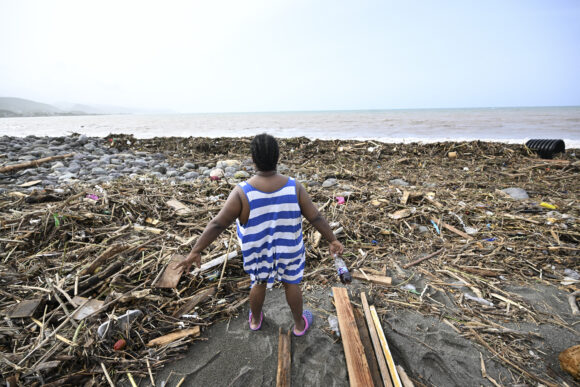Investors in bonds intended to help Jamaica cover the costs of a natural catastrophe won’t be affected by the havoc wrought by Hurricane Beryl, even as the prime minister declares the entire Caribbean island a disaster area.
As the earliest category five hurricane on record, Beryl made landfall in Jamaica on Wednesday, bringing high-speed winds, sheets of rain and a wave of destruction to the island nation. Investors in the country’s $150 million catastrophe bond were monitoring the situation closely to assess whether they’d be called on to pay up and help cover part of the damage.
However, due to the specific terms of the bond, which was arranged by the World Bank, investors will be shielded from any financial losses.
Beryl Regains Strength, On Track to Reach Texas as Hurricane
“The air pressure required for a payout of the cat bond wasn’t reached,” according to an advisory sent to investors by Switzerland-based Plenum Investments, which is exposed to the bond through one of its funds. As a result, the expectation is that holders of the Jamaica bonds won’t lose any money, it said.
While fortunate for investors, the outcome represents a challenge for Jamaica. The country, an early mover in using cat bonds to protect against losses caused by events such as hurricanes, now faces the task of cleaning up after Beryl. Its cat bond pays holders 7% above the US Treasury rate as compensation for the risk they agree to take on.
Jamaica has a total disaster safety net of $1.6 billion, making it one of the most prepared Caribbean nations when it comes to dealing with the financial cost of hurricanes. That pot includes insurance policies and other lines of credit.
Jamaica’s sovereign bonds were little impacted, with dollar notes due in 2028, 2039 and 2045 edging up, according to indicative pricing data compiled by Bloomberg. The extra yield investors demand to hold the debt over similar US Treasuries has fallen nearly 30 basis points in the past year, data from JPMorgan Chase & Co. show.
Catastrophe bonds allow issuers to pass part of their risk over to capital markets. Issuance has picked up lately, with factors including climate change, population density and inflation adding to the potential losses that insurers face. Investors in the bonds stand to generate market-beating returns if a predefined catastrophe doesn’t occur but can face substantial losses if it does.
In 2021, Jamaica became the first small island state to independently sponsor a cat bond, persuaded by the rapid payouts of such instruments. Its government renewed the bond in April, obtaining a fresh $150 million in insurance cover for named storms.
The deal was jointly structured by Swiss Re Capital Markets and Aon Securities. It attracted 15 global investors and provided insurance protection for four hurricane seasons, according to the World Bank, which helped arrange both Jamaica transactions as part of a push to promote cat bonds in less-developed countries.
“The need for the Caribbean to prepare for disaster impacts cannot be overstated, as it is one of the most vulnerable regions globally,” Lilia Burunciuc, the World Bank’s country director for Caribbean countries, said in April.
The International Federation of Red Cross said the unprecedented, early-season formation of Beryl underscores the new reality of a warming climate for small Caribbean nations. “Storms are more likely to rapidly intensify and become stronger, causing severe destruction and giving communities less time to recover in between shocks,” it said.
Cat bonds have been around for more than 25 years and last year underpinned the most profitable investment strategy for the hedge fund industry, with returns of about 20%. This year has already seen record issuance and a widening of the investor pool.
Some veterans of the market have urged caution, however, amid warnings from meteorologists that this year’s hurricane season will be unusually active.
For investors in Jamaica’s cat bond, Beryl proved a near miss. The instrument divides the country into 19 sub-areas and only pays out if the storm’s central air pressure falls below a defined minimum level in one or more of those sub-areas, according to Plenum. For hurricanes, lower pressure usually means higher wind speed.
The bond’s minimum payout is set at 30% of the nominal value, though the payout can go as high as 100% depending on the intensity of the storm and the number of sub-areas affected.
Beryl swept through six of the 19 sub-areas defined in the bond’s terms, but “based on the central pressure data published by the National Hurricane Center, the air pressure required for a payout of the cat bond wasn’t reached in any of the sub-areas,” Plenum said in its note to investors.
It’s unclear whether investors in cat bonds tied to other countries in Beryl’s path will also avoid losses.
The World Bank earlier this year issued a cat bond that provides up to $125 million of insurance protection for Mexico against named Atlantic storms. It requires a major hurricane, with specific pressure readings, to trigger a payout.
Related:
Topics Catastrophe Profit Loss
Was this article valuable?
Here are more articles you may enjoy.



 Scientists Concerned That a Bird Flu Pandemic Is ‘Unfolding in Slow Motion’
Scientists Concerned That a Bird Flu Pandemic Is ‘Unfolding in Slow Motion’  Microsoft Tells Texas Agencies They Were Exposed in Russian Hack
Microsoft Tells Texas Agencies They Were Exposed in Russian Hack  The 10 Major Risks Shaping Insurance Today
The 10 Major Risks Shaping Insurance Today  AI and APIs: Essential Tools for Zurich Insurance Group’s Digital Leap
AI and APIs: Essential Tools for Zurich Insurance Group’s Digital Leap 

